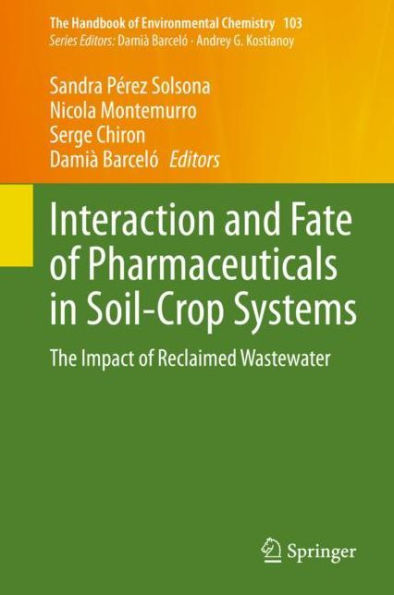
Interaction and Fate of Pharmaceuticals in Soil-Crop Systems: The Impact of Reclaimed Wastewater
530
Interaction and Fate of Pharmaceuticals in Soil-Crop Systems: The Impact of Reclaimed Wastewater
530Hardcover(1st ed. 2021)
-
PICK UP IN STORECheck Availability at Nearby Stores
Available within 2 business hours
Related collections and offers
Overview

Product Details
| ISBN-13: | 9783030612894 |
|---|---|
| Publisher: | Springer International Publishing |
| Publication date: | 01/29/2021 |
| Series: | The Handbook of Environmental Chemistry , #103 |
| Edition description: | 1st ed. 2021 |
| Pages: | 530 |
| Product dimensions: | 6.10(w) x 9.25(h) x (d) |
About the Author
Dr. Nicola Montemurro is a biologist and expert in wastewater treatment for its reuse in agriculture. He holds a PhD degree in Biodiversity, Agriculture and Environment in 2017. His PhD research studied the effects of the use of reclaimed municipal wastewater for crop irrigation. He is currently working as a postdoctoral research fellow at the Institute of Environmental Assessment and Water Research (Barcelona, Spain) to assess the fate of emerging organic contaminants in agricultural crops and their potential risks for the environment and human health. His research focuses on the presence of new emerging contaminants and their metabolites/Transformation products in different matrices (water, soil, crops, and earthworms). The assessment of the presence and fate of emerging environmental contaminants is based on field studies and laboratory scale experiments in controlled greenhouses. He is constantly involved in development of new analytical methods based on liquid chromatography coupled to mass spectrometry of low and high resolution such as Q-Exactive Orbitrap and Hybrid Q-ToF systems.
Dr. Serge Chiron, born in Avignon in 1965, he obtained a B.Sc. in Agrochemistry from the University of Grenoble and a Ph.D. in Analytical Chemistry from the University of Barcelona in 1995. He is currently working as a research director at the French National Research Institute for Sustainable Development (IRD) in Montpellier. He was also appointed as a permanent lecturer at the University of Marseille from 2001 to 2011. His research career has been focused in the area of environmental chemistry with a particular interest in the degradation processes of emerging contaminants in water and soil including phohemical and biodegradation processes as well as their remediation at source using advanced oxidation processes (AOPs) and nature-based solutions (NBS). According to Scopus, he has an H-index of 36 and a total number of citations over 5 000. He has been involved in a research chair with Veolia - risk analysis related to emerging contaminants in water bodies - and in several national and European research projects dealing with the fate of emerging contaminants in river basins or in agroecosystems through wastewater reuse. He is currently also involved in the development of innovative decentralized water treatment systems, which has led to several patents.
Dr. Damià Barceló obtained a Ph.D. in Analytical Chemistry from University of Barcelona in 1984 and he was a Post-doc at the Vrije Universiteit, Amsterdam, NL between 1985-86. At present he is Full Research Professor at the Institute of Environmental Assessment and Water Studies IDAEA-CSIC (Barcelonasub 1100), an H index of 147/117, and more than 100,000/70,000 ISI Citations (Google scholar/Scopus),and the supervision of 60 PhD thesis (July 2020). He is Co-Editor in Chief of the HEC book series from Springer-Nature and several journals .
Table of Contents
The Journey of Human Drugs from Their Design at the Bench to Their Fate in Crops.- Sources of Pharmaceuticals in water.- Environmental, economic, and ethical assessment of the treated wastewater and sewage sludge valorization in agriculture.- Wastewater Reuse in Agriculture: Effects on Soil-Plant System Properties.- Uptake and Translocation of Pharmaceuticals in Plants: Principles and Data Analyses.- Soil Sorption and Degradation Studies of Pharmaceutical Compounds Present in Recycled Wastewaters Based on Enantiomeric Fractionation.- Uptake and effects of pharmaceuticals in the Soil-Plant-Earthworm System.- Metabolism of Pharmaceuticals in Plants and their Associated Microbiota.- Impact of PhACs on soil microorganisms.- Biomarkers in earthworms.- Vermiremediation of Pharmaceutical-Contaminated Soils and Organic Amendments.- Constructed wetlands and phytoremediation as a tool for pharmaceutical removal.- Development of methods for the determination of PhACs in soil/earthworm/crop system irrigated with reclaimed water.- Analytical approaches for the determination and identification of drug metabolites in plants after uptake.- Conclusions and Future Perspectives.
